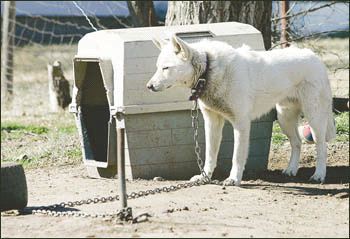Not Fit to Be Tied
www.DodgeGlobe.com
By Eric Swanson
February 16, 2005, Dodge City, Kansas - A dog is tied to a chain in the backyard of a house on Seventh Avenue Tuesday afternoon. A new ordinance has been passed regulating the amount of time a dog can legally be tethered.
As Dodge City's animal control director, Glenna Walker regularly sees dogs who have suffered because their owners kept them tied up for several hours at a time. Some dogs died of heat exhaustion, some strangled on their leashes and still others were hurt or killed because they could not escape when a bigger, more aggressive dog attacked them.

But the days when dog owners could tie up their dogs for hours without a break are coming to an end, thanks to a new city ordinance that restricts how long people can tether their dogs. "It's an idea whose time has come," Walker said Tuesday. "It is just no longer proper to keep dogs in that manner."
Last week, the Dodge City Commission approved the tethering ordinance and several other measures designed to strengthen the city's animal control regulations. The changes, which included a broader definition of cruelty to animals, will not take effect until June 1 to give animal owners more time to adjust.
The tethering ordinance does not bar people from putting their dogs outside for a few minutes, but it does say the dog cannot be tied or chained for more than an hour at a time. After the first hour, the owner must give the dog at least a three-hour break before putting it back on the tether.
"That's to allow people - you know, the people that maybe have a dog in the house, and they just want to put it out there for a few minutes in the morning so it can go to the bathroom, or put it out at lunch - that is still allowed," Walker said.
Dogs cannot be tethered for more than three hours a day.
Violations of the tethering ordinance are misdemeanors under the city code and could be punished by a fine of up to $2,500, up to one year in jail or both.
Tethering dogs
Dodge City joins at least 25 other communities in the United States that have banned or restricted the practice of tethering dogs, according to the Humane Society of the United States. Maumelle, Ark.; Tucson, Ariz.; and New Hanover, N.C., forbid dog owners to chain or tie their dogs under any circumstances, while many other communities allow tethering only under certain conditions.
But what is wrong with keeping a dog outside on a chain while its owner is away? Do laws restricting tethering actually benefit the dogs they are intended to help, or the community?
Here are some common questions and answers about tethering from Walker and the Dodge City Animal Shelter.
Why is it cruel to tether a dog?
Dogs are social animals which have evolved to live in a pack environment. In today's world, the company of humans has replaced the pack. Dogs who live on a tether are isolated from family activities, and their psychological needs are not met.
"Psychologically, dogs are just not meant to live that way, and eventually it inflicts a toll on them," Walker said. "Their behavior becomes poor. They can become aggressive or extremely fearful, which they'll bite you either way."
Why is tethering dangerous to dogs?
Tethered dogs cannot escape from cruel humans, other animals or biting insects, and they are at the mercy of weather conditions. The tether often becomes tangled, preventing the dog from reaching shelter or shade.
Many dogs strangle to death after their tether becomes tangled around other objects, or they die from heat exhaustion or third when their water bowls are tipped over.
Why is it dangerous to people to tether a dog?
Dogs which are tethered for long periods of time can become very aggressive. When confronted with a perceived threat, a dog has the option of fight or flight, but a tethered dog cannot flee from what he perceives as a threat and feels forced to fight.
How does the community as a whole benefit from the tethering ordinance?
The areas where dogs are tethered are generally unsightly. Since the dog is forced to eat, sleep, urinate and defecate in the same area, the grass is worn down and an area of mud and feces surrounds the dog.
Tethered dogs often bark incessantly, creating a disturbance in the neighborhood.
In 2004, Dodge City Animal Control officers investigated 238 reports of animal cruelty at taxpayer expense, and about 90 percent of those reports involved tethered dogs. Twelve percent of all court cases filed by Animal Control officers involved charges of animal cruelty with tethered dogs.
Walker said she thought more U.S. communities would begin outlawing or restricting the practice of tethering dogs as people understand that tying their dogs up for long periods is inhumane.
"You're never going to eliminate animal cruelty, because we can't eliminate child abuse or domestic violence or any of those things either," she said. "But at least we can, hopefully, change some people's attitudes."
Next week: alternatives to tethering.
